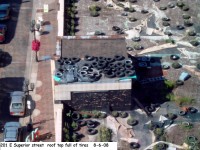Up on a Roof
Calling all inspectors. Help me help a prosecutor decide what violations this picture contains
. The person is storing tires on a roof and says they’re planters. Illegal outdoor storage may be one violation but I’m looking for something creative



Years ago IACE had something on this and what I remembered was the EPA
here is the link for storage of tires:
http://www.epa.state.il.us/land/tires/
2. Cleanup
Forced Removals
Although it is the least common, the most important activity carried out by the Used Tire Program is forced tire removals. The Illinois EPA has authority under section 55.3. of the Environmental Protection Act to undertake appropriate preventive or corrective actions when an accumulation of used tires presents a threat to the environment or public health.
If the responsible (liable) party does not undertake the preventative/corrective actions outlined in a notice issued pursuant to Section 55.3.d of the Environmental Protection Act, then the Illinois EPA may recover costs associated with the cleanup as well as punitive damages up to twice the cost of the cleanup.
Locally here in Hinsdale – I would also use our Municipal Code:
4-1-3: WATER SOURCES:
A. It shall be unlawful and a nuisance for any person to obstruct or pollute any watercourse or source of water supply in the Village. (1965 Code, sec. 16-3.03)
B. Any stagnant pool of water in the Village is a potential breeding place for mosquitoes and other insects and such a pool of water is therefore declared a nuisance. The term “stagnant pool of water” shall include, but not be limited to, swimming pools with inadequate recirculation, ponds, bird baths and low areas where stagnant water collects.
In addition to other penalties specified in this Code, the Village Manager may cause the nuisance to be immediately abated by chemical spray or other means and the cost of abatement shall be assessed against the owner of the premises. (6-15-79)
Mosquitos would be a health hazard and it’s clear many tires on the roof do not have plantings.
In addition I would use the IPMC Accumulation of rubbish.
Improper roof material – i.e. – tires
Appears as if the roof materials are in a state of failure based on the corners pulling up.
Here are a couple of “creative” ideas for this situation.
1. 1999 BOCA National Fire Prevention Code Chapter 21 F-2101.4 Waste Accumulation, “Accumulation of…or rubbish of any type shall not be permitted to remain on any roof…”
2. 1999 BOCA National Building Code Chapter 16 1606.1.1 Loads Not Specified, “The code official shall approve the required LIVE LOAD for any occupancy not specifically provided for in Table 1606.
…as follows
3. 1999 BOCA National Building Code Chapter 16 1607.3 Minimum Roof Live Loads, “Ordinary roofs,…shall be designed for the LIVE LOADS as specified in Table 1607.3…”
4. 2003 IPMC Chapter 3 302.2 Grading and Drainage, “All premises…to prevent the accumulation of stagnant water thereon…”
When I was a teenager we threw an old tire on a camp fire. I can still remember the incredibly intense heat the tire gave off when it finally ignited. The intensity and duration of the burn was such that it scared us country boys a great deal.
If one of those tires were to ignite the sped of the burn and the location (on a roof) would make the damage to property almost certain. More likely, if there was a fire in the interior of the building that penetrated the roof and ignited the tires and/or caused a roof failure allowing the tires to fall into the burning interior of the building the fire spread would be exponential. I wonder if the fire code side would not be good approach.
I googled “car tire fires” and came across an EPA website: http://www.epa.gov/waste/conserve/materials/tires/fires.htm
The EPA site starts off by stating “Tire fires often become major hazardous incidents…” and that “The average passenger car tire is estimated to produce over 2 gallons of oil when burned.” Needles to say the additional information the site paints and even more ominous picture of tire fires. The EPA could add to the fire code approach or provide another avenue for attack from the environmental side.
Additionally, I believe the storage of tires is regulated, least I believe that is why they continue to charge a disposal fee whenever I have my car tires changed.
Good Luck,
Jerry
Planters on roof suggest occupancy change which could envoke access, exiting, and load requirements.
If planters impede the flow of water to the roof drains the planters could result in an increase in the rain loads required by code.
As others stated previously added weight of planters. Would need to look into new provisions related to green roofs.